Check out the quick starter guide to help you get started with this rain sensor immediately.
Or continue to learn the configuration for the various operation modes available from this rain sensor.
Rain Sensor Operation Mode
This rain sensor module can provide you with various mode of operations for a wide range of rain or water sensing applications.
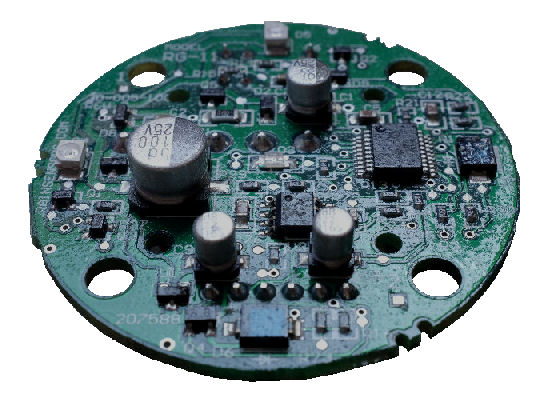
The top of this rain sensor circuit module is mounted with a pair of IR emitter and receiver to detect light leakage indicating a presence of water on the surface of the sensor’s optical dome cover.
On board is also a controller which process the IR signal and trigger a relay (dry contact switch) according to the operation mode selected. The following section will introduce the various operation mode that you can set to this rain sensor.
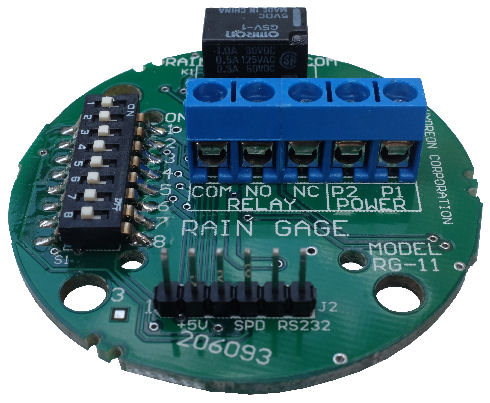
Flipping over to the bottom of this rain sensor module, you will see the 8pos DIP switch, a contact relay, 5pos screw terminal connector (blue), and 6pos header pins.
The 5pos screw terminal connector consist of the relay output (COM, NO, NC), and power supply input (P1, P2). The relay output NC (normally close) is contacted with COM when there is no trigger from the sensor, and the NO (normally open) is contacted with COM when there is a trigger from the sensor.
NOTE: Note the relay inside this rain sensor module is rated for only up to 24V 1 A (max). Please ensure that your interfacing device or circuitry is NOT more than this maximum rating.
The power input (P1, P2) accept a wide voltage range from 12V-24V (AC or DC). There is no polarity on the power input. You can connect the positive power supply line to either P1 or P2, the negative line to the other respective P2 or P1.
You can visit the installation guide for more information on the wiring and connection.
Operation Mode Configuration
This rain sensor has 6 modes of sensing operations. You will need to set the DIP switch in order to configure the settings correctly for the sensor operation.
The 8pos DIP switch allows you to set the rain sensor algorithm for your rain/water detection application. The following are the 6 modes of operation that you can select for the rain sensor.
Mode of Operation
- Mode 0 – Tipping Bucket
- Mode 1 – Rain Sensing (most popular configuration)
- Mode 2 – Condensation Sensor
- Mode 3 – Wiper Control
- Mode 4 – Irrigation Control
- Mode 6 – Drop Detector
Mode 0 – Tipping Bucket
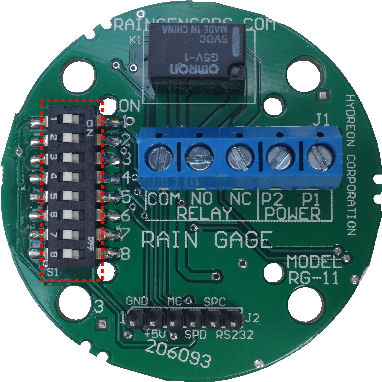
Tipping bucket mode simulates a physical water collecting bucket. When this bucket has accumulated the water to the bucket size, the output will be triggered for 50msec. This output pulse can be captured from an external controller. Each pulse represents an amount of the water collected by the virtual bucket. The sum of the water collected will be translated to the rainfall rates.
The rainfall measurement is done through estimated electronic sensing. It may not be very accurate but enough for simple and quick rainfall gauge application.
There is a total of 6 bucket size that you can set to. Check out the following DIP switch settings.
| Tipping Bucket Function | DIP Switch Settings | |||||||
| 1 | 2 | 3 | 4 | 5 | 6 | 7 | 8 | |
| Bucket Size = 0.01″ | 0 | 0 | 0 | 0 | 0 | 0 | 0 | 0 |
| Bucket Size = 0.001″ (Sensitive) | 1 | 0 | 0 | 0 | 0 | 0 | 0 | 0 |
| Bucket Size = 0.0001″ (Very sensitive) | 0 | 1 | 0 | 0 | 0 | 0 | 0 | 0 |
| Bucket Size = 0.2mm | 0 | 0 | 1 | 0 | 0 | 0 | 0 | 0 |
| Bucket Size = 0.01mm (Sensitive) | 1 | 0 | 1 | 0 | 0 | 0 | 0 | 0 |
| Bucket Size = 0.001mm (Very sensitive) | 0 | 1 | 1 | 0 | 0 | 0 | 0 | 0 |
| Reserved for system test | 1 | 1 | 1 | 1 | 0 | 0 | 0 | 0 |
Mode 1 – Rain Sensing
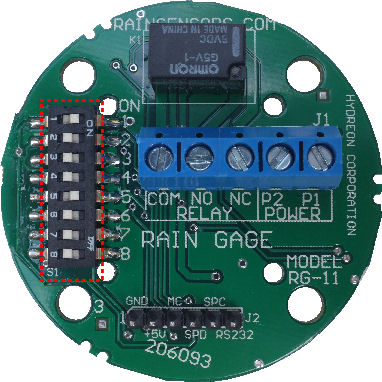
This rain sensing operation is the most commonly used mode. The output will be triggered when rain or water is detected on the clear transparent dome cover.
You can set to 4 different level of sensitivity. The most sensitive mode can detect very light rain. Therefore any light rain or heavy rain will activate the relay output.
If your application does not need such a high sensitivity, you can lower the sensitivity by setting the rain sensor to trigger the relay output only when heavy rain is detected.
DIP switch no. 3 allows you to select the behaviour of the relay out. If you want the relay to deactivate faster after the rain stops, set the DIP switch no. 3 to ‘0’.
When the rain stops, the sensor’s output relay will be deactivated even there is still water residues on the sensor’s dome cover. It will take about 2-3 minutes for the sensor to confirm a rain stop status. You may not want the sensor to deactivate so quick after the rain stops. This may sometimes cause unintended system behaviour. You can set DIP switch no.3 to ‘1’, to allow the sensor to hold on for another 15 minutes before it deactivates the output. This waiting allows the sensor to provide more time for your system to react to the stopped rain.
This sensor also has a built-in LUX sensor (lighting intensity sensor). For an advanced application like retracting of window shades, you may want the sensor to trigger open the window’s shades when the environment becomes too dark. The dark environment will occur when it rains or when the evening/night time arrived. You can set DIP switch no. 4 to ‘1’., if you want the relay to trigger when it rains or when the sky becomes dark.
| Rain Sensing Function | DIP Switch Settings | |||||||
| 1 | 2 | 3 | 4 | 5 | 6 | 7 | 8 | |
| First detected rain drop to trigger output (Very sensitive) | 0 | 0 | OP | DD | 1 | 0 | 0 | 0 |
| Light rainfall to trigger output | 1 | 0 | OP | DD | 1 | 0 | 0 | 0 |
| Medium rainfall to trigger output | 0 | 1 | OP | DD | 1 | 0 | 0 | 0 |
| Heavy rainfall to trigger output | 1 | 1 | OP | DD | 1 | 0 | 0 | 0 |
| (OP) Output off when rain stops | 0 | |||||||
| (OP) Output off, 15 minutes after rain stops | 1 | |||||||
| (DD) No Dark Detect – Normal operation | 0 | |||||||
| (DD) Dark Detect | 1 | |||||||
Mode 2 – Condensation Sensor
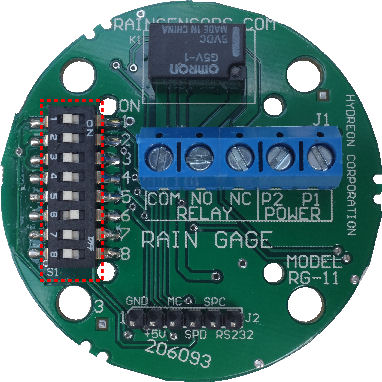
The rain sensor can be configured as a condensation sensor. When dew water droplet or condensation starts to appear on the dome cover, the relay output will get triggered.
There is a total of 4 condensation sensitivity level to choose from. Check out the following DIP switch settings table.
| Condensation Sensor Function | DIP Switch Settings | |||||||
| 1 | 2 | 3 | 4 | 5 | 6 | 7 | 8 | |
| Slight Condensation to trigger output | 0 | 0 | 0 | 0 | 0 | 1 | 0 | 0 |
| Low Condensation to trigger output | 1 | 0 | 0 | 0 | 0 | 1 | 0 | 0 |
| Medium Condensation to trigger output | 0 | 1 | 0 | 0 | 0 | 1 | 0 | 0 |
| Heavy Condensation to trigger output | 1 | 1 | 0 | 0 | 0 | 1 | 0 | 0 |
Mode 3 – Wiper Control
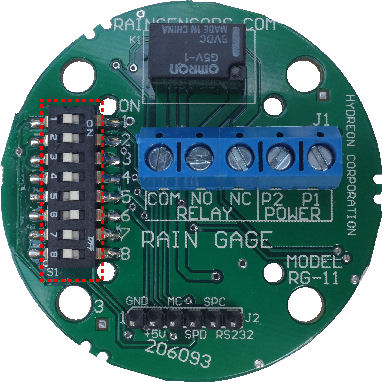
In this wiper control mode, when the rainwater is detected, the onboard relay will pulse periodically. This pulse can be used to trigger your vehicle windscreen wiper system or trigger a motorised pump, or an alarm light.
There is two range of time period for the pulse. You can choose a normal cycle time (1.2 to 3 sec), or a longer cycle time (3 to 8sec) using DIP switch 3. The DIP switch 4, 2, 1 control the finer speed or the pulse period.
| Wiper Control Function | DIP Switch Settings | |||||||
| 1 | 2 | 3 | 4 | 5 | 6 | 7 | 8 | |
| Normal Wiper Control | 0 | 0 | CT | 0 | 1 | 1 | 0 | 0 |
| Wipe More | 1 | 0 | CT | 0 | 1 | 1 | 0 | 0 |
| Wipe a lot More | 0 | 1 | CT | 0 | 1 | 1 | 0 | 0 |
| Wipe a whole lot More | 1 | 1 | CT | 0 | 1 | 1 | 0 | 0 |
| Wipe Less | 0 | 0 | CT | 1 | 1 | 1 | 0 | 0 |
| Wipe a lot Less | 1 | 0 | CT | 1 | 1 | 1 | 0 | 0 |
| Wipe a whole lot Less | 0 | 1 | CT | 1 | 1 | 1 | 0 | 0 |
| Wipe hardly at all | 1 | 1 | CT | 1 | 1 | 1 | 0 | 0 |
| (CT) Normal Cycle Time (1.2 to 3 sec) | 0 | |||||||
| (CT) Long Cycle Time (3 to 8 sec) | 1 | |||||||
Mode 4 – Irrigation Control
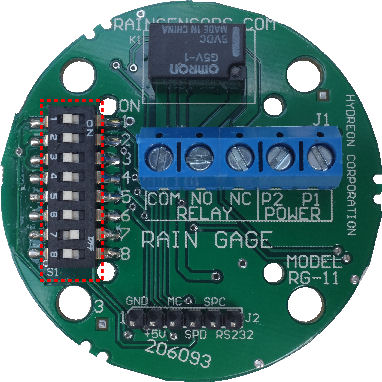
The rain sensor can operate like a rain gauge for irrigation control. The sensor can measure an approximate rainfall over a period of time. If it detects sufficient amount of rainfall, the relay output will not be triggered. If the sensor detects little rain, the relay output will be triggered.
The sensor will inhibit watering upon accumulation of 0.2 inches of water. The “ER” mode allows you to set the simulated water evaporation rate. It is like a decay factor base on the accumulation water collected from this rain gauge. Once the value in this rain gauge is gone, the rain will trigger the irrigation. You can set the evaporation rate too high or low.
When it is raining, you can disable the output so that the irrigation operation will not be activated. This can be set with the “ST” DIP switch. The output can also be disabled during a freezing weather condition.
DIP switch 1, 2, 3 is the finer control for the amount of water irrigation that is needed.
| Irrigation Control Function | DIP Switch Settings | |||||||
| 1 | 2 | 3 | 4 | 5 | 6 | 7 | 8 | |
| Typical Water Control. Inhibit watering for up to 5 days | 0 | 0 | 0 | ST | FZ | 0 | 1 | ER |
| Water More | 1 | 0 | 0 | ST | FZ | 0 | 1 | ER |
| Water a lot More | 0 | 1 | 0 | ST | FZ | 0 | 1 | ER |
| Water Less | 0 | 0 | 1 | ST | FZ | 0 | 1 | ER |
| Water a lot Less | 1 | 0 | 1 | ST | FZ | 0 | 1 | ER |
| (ST) Inhibit irrigation during a storm | 0 | |||||||
| (ST) Allow irrigation during a storm | 1 | |||||||
| (FZ) Inhibit irrigation during freeze | 0 | |||||||
| (FZ) Allow irrigation during freeze | 1 | |||||||
| (ER) Normal Evaporation Rate | 0 | |||||||
| (ER) High Evaporation Rate | 1 | |||||||
Mode 6 – Water Drop Detector
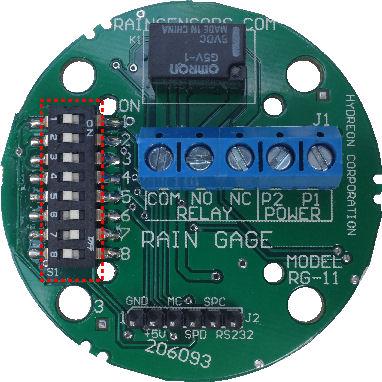
This rain sensor can also be used to sense the size or intensity of the water drop. The output will be pulsed for the water dropping onto the sensor.
You can set a longer (200ms pulses) or shorter pulses (100ms pulses) using DIP switch 3. The number of pulses determines the size or intensity of the water. Intense water drops will have more pulses than a light water drizzling.
| Water Drop Detector Function | DIP Switch Settings | |||||||
| 1 | 2 | 3 | 4 | 5 | 6 | 7 | 8 | |
| Normal drop threshold | 0 | 0 | PD | 0 | 0 | 1 | 1 | 0 |
| Sensitive Drop threshold. Expect rare false trigger. | 1 | 0 | PD | 0 | 0 | 1 | 1 | 0 |
| High Drop threshold. Trigger only with large drops. | 0 | 1 | PD | 0 | 0 | 1 | 1 | 0 |
| (PD) One pulse per drop, longer pulses for bigger drops | 0 | |||||||
| (PD) Multiple pulses per larger drop | 1 | |||||||
Rain Sensor Intelligent Water Sensing
This rain sensor module uses a single IR sensing technique to detect rain or water. By analysing the signal captured by the IR sensor, the sensor is able to synthesise various mode of operation and implementation.
The rain sensor does not have a very high accuracy, but it is sufficient for a basic intelligent control automation system.
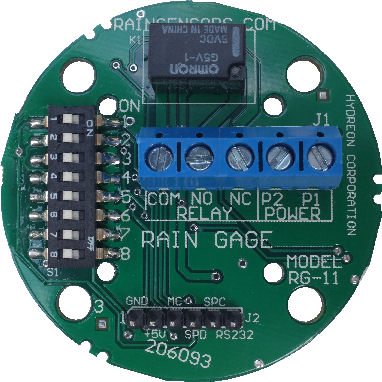
Check out the detail specification of this RG-11 rain sensor in our main page.
The installation steps for the rain sensor is also available here.
Or click here to buy this rain sensor from this online website.
If you are also looking for a USB or Ethernet controller interfacing to this rain sensor, check out our list of I/O controller products.
